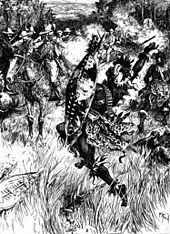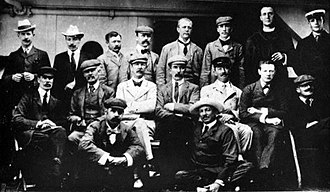Frederick Russell Burnham
During World War I, Burnham was selected as an officer and recruited volunteers for a U.S. Army division similar to the Rough Riders, which Theodore Roosevelt intended to lead into France.
Burnham was born on May 11, 1861, on a Dakota Sioux Indian reservation in Minnesota, to a missionary family living near the small pioneer town of Tivoli (now gone), about 20 miles (32 km) from Mankato.
[25] In Globe, Arizona, Burnham unwittingly joined the losing side of the Pleasant Valley War before mass killing started, and only narrowly escaped death.
The time when great scouts like Kit Carson, Daniel Boone, and Davy Crockett could explore and master the wild and uncharted Western territories was coming to a close.
[42] Burnham, along with his wife and son, was trekking the 1,000 miles (1,609 km) north from Durban to Matabeleland with an American buckboard and six donkeys when war broke out between Rhodes's British South Africa Company and the Matabele (or Ndebele)[n 2] King Lobengula in late 1893.
Leander Starr Jameson, the company's Chief Magistrate in Mashonaland, hoped to defeat the Matabele quickly by capturing Lobengula at his royal town of Bulawayo, and so sent Burnham and a small group of scouts ahead to report on the situation there.
In desperation, Wilson sent Burnham and two other men, Pearl "Pete" Ingram (a Montana cowboy) and William Gooding (an Australian), to cross the Shangani River, find Forbes, and bring reinforcements.
[51] The version of events recorded by history is based on the accounts of Burnham, Ingram and Gooding, the Matabele present at the battle (particularly inDuna Mjaan), and the men of Forbes' column.
[52][53][54][55][56] While all of the direct evidence given by eyewitnesses supports the findings of the Court of Inquiry, some historians and writers debate whether or not Burnham, Ingram and Gooding really were sent back by Wilson to fetch help, and suggest that they might have simply deserted when the battle got rough.
The colonists' defenses in Matabeleland were undermanned due to the ill-fated Jameson Raid into the South African Republic (or Transvaal), and in the first few months of the war alone hundreds of white settlers were killed.
With few troops to support them, the settlers quickly built a laager in the centre of Bulawayo on their own and mounted patrols under such figures as Burnham, Robert Baden-Powell, and Frederick Selous.
[73][74] The turning point in the war came when Burnham and Bonar Armstrong, a company native commissioner, found their way through the Matopos Hills to a sacred cave not many miles from the Mangwe district, to a sanctuary then known only to the Matabele where Mlimo had been hiding.
[85] Field Marshal Frederick Roberts, one of the British Army's most successful commanders of the 19th century, was appointed to take overall command of British forces, relieving General Redvers Buller, following a number of Boer successes in the early weeks of the war,[86] including the Siege of Mafeking, in which Baden-Powell, his small regiment of men, and the townspeople had been besieged by thousands of Boer troops since the conflict began.
Roberts asked General Frederick Carrington, who had commanded the British forces in Matabeleland three years earlier, whom he should appoint as his Chief of Scouts in South Africa.
[89] He gave himself up in order to obtain information on the enemy, which he did, and then he escaped from his guards and succeed in reaching British occupied Bloemfontein safely after two days and nights on the run.
[74] From his youth on the open plains, Burnham's earliest playmates were Sioux Indian boys and their ambitions pointed to excelling in the lore and arts of the trail and together they dreamed of some day becoming great scouts.
Baden-Powell had written at length about reconnaissance and tracking, but from Burnham he learned many new dimensions such as how to travel in wild country without either a compass or map, how to discover nearby dangers by observing animals, and the many techniques for finding potable water.
During their joint scouting missions, Baden-Powell and Burnham discussed the concept of a broad training program in woodcraft for young men, rich in exploration, tracking, fieldcraft, and self-reliance.
[139][140] After convalescing, Burnham became the London office manager for the Wa Syndicate, a commercial body with interests in the Gold Coast and neighboring territories in West Africa.
[147] Burnham was put in charge of a private security detail, 250 men hired by Hammond, who in addition to owning large investments in Mexico was a close friend of Taft from Yale and a U.S. vice-presidential candidate in 1908.
Moore, a Texas Ranger, discovered a man holding a concealed palm pistol standing at the El Paso Chamber of Commerce building along the procession route.
[152] After the Taft-Díaz summit, Burnham led a team of 500 men in guarding mining properties owned by Hammond, J. P. Morgan, and the Guggenheims in the Mexican state of Sonora.
During this period, Burnham was one of the 18 officers selected by former U.S. president Theodore Roosevelt to raise a volunteer infantry division for service in France in 1917 shortly after the United States entered the war.
[156] A plan to raise volunteer soldiers from the Western U.S. came out of a meeting of the New York-based Rocky Mountain Club and Burnham was put in charge of both the general organization and recruitment.
[164] During the Second Boer War, Burnham and Duquesne were each under orders to assassinate the other, but it was not until 1910 that the two men first met while both were in Washington, D.C., separately lobbying Congress to pass a bill in favor of the importation of African game animals into the United States (H.R.
[170] The spot where Burnham found oil was land where "as a small boy he used to graze cattle, and shoot game which he sold to the neighboring mining districts to support his widowed mother and infant brother.
[187][188] Burnham's wife of 55 years, Blanche (February 25, 1862 – December 22, 1939) of Nevada, Iowa, accompanied him in very primitive conditions through many travels in both the Southwest United States and southern Africa.
[196][197] To the Memory of the Child: Nada Burnham, who "bound all to her" and, while her father cut his way through the hordes of the Ingobo Regiment, perished of the hardships of war at Buluwayo on 19 May 1896, I dedicate these tales—and more particularly the last, that of a Faith which triumphed over savagery and death.
[15] In 1899, Frank E. Fillis brought his circus and stage show "Savage South Africa", featuring a number of Zulu performers, to the Empress Theatre at Earls Court in London as part of the "Greater Britain Exhibition".
Sir H. Rider Haggard, inventor of the lost world literary genre, was heavily influenced by the larger than life adventures of his friend Burnham as he penned his fictional hero Allan Quatermain.







Hover your mouse over each man for his name; click for more details.









